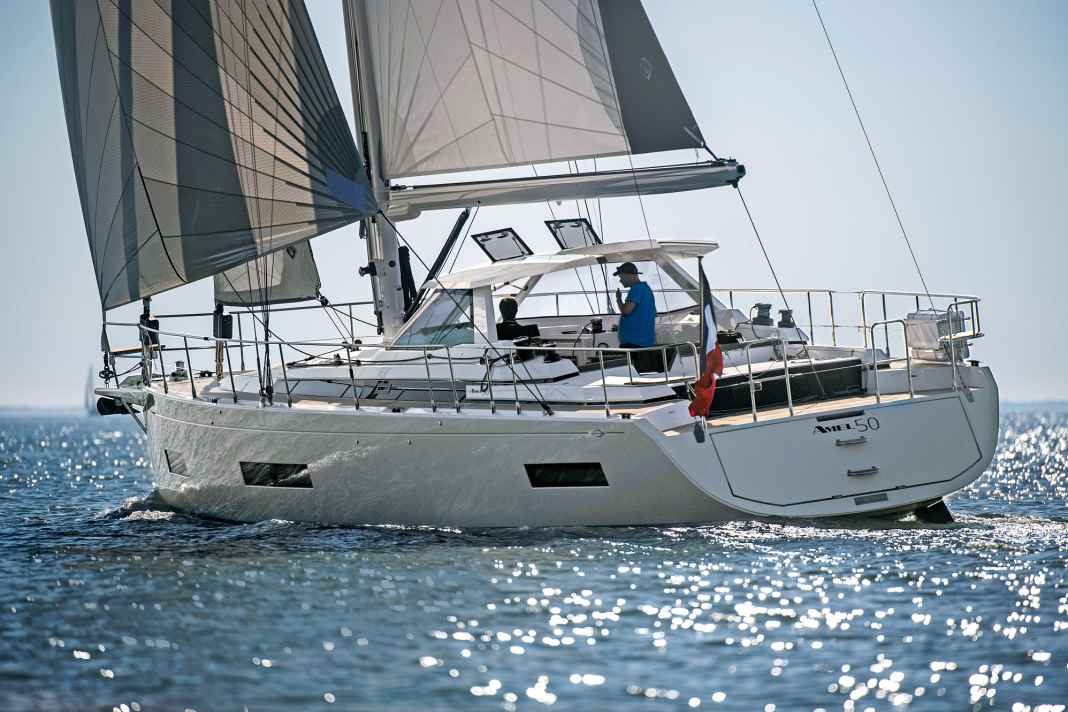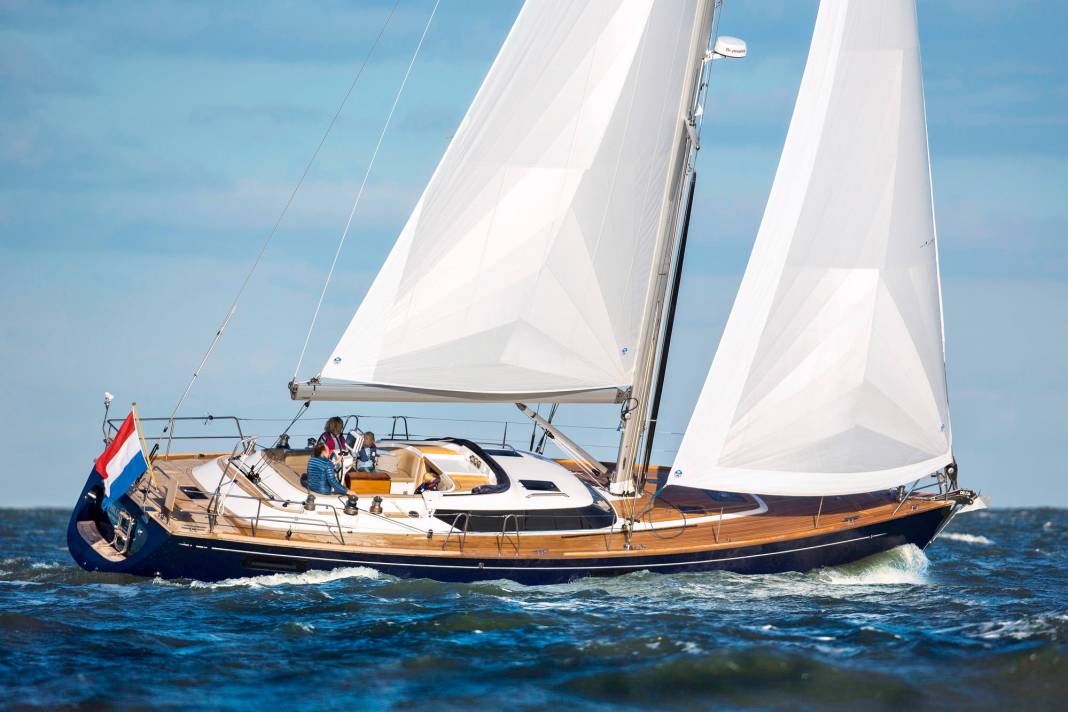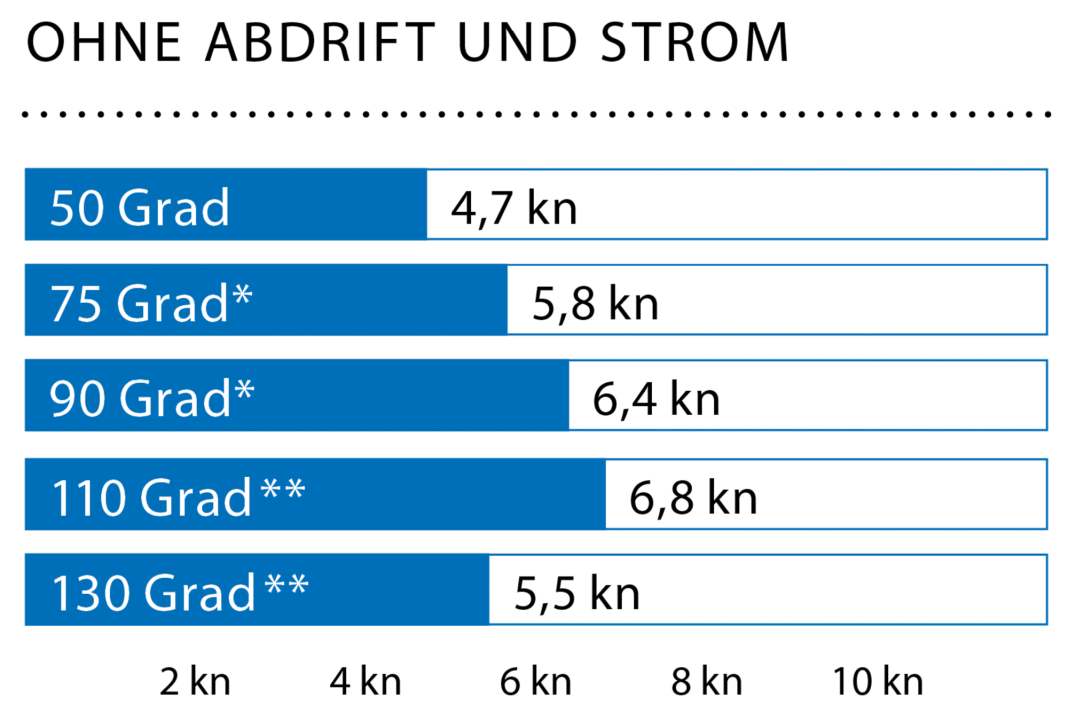





The list, which does not exist in this form and completeness at any other series boatyard, is an internal document. No owner will ever get to see it. Because everything it contains will be on board when Amel hands over the new yacht. It lists almost a hundred items: Oil and fuel filters, for example, a set of zinc anodes, an impeller, a V-belt, shackles, jumper cables for the batteries, a can of WD-40, grease for winches and propellers - everything you need if you want to be autonomous at sea for longer.
However, it is not just spare and wear parts that are part of the unusually extensive equipment. There are also deck scrubbers and boat hooks, a pump for the dinghy, a flagpole with a national flag and the saling flags Charlie and November. Below deck, the shipyard's care goes even further: the list includes twelve pillows, two bathrobes, two sets of towels and beach towels, two hot-air hairdryers, 30 bin bags and 40 clothes hangers, to name but a few. As well as, it goes without saying in France, two bottles of champagne, a bottle of Pineau, a bottle each of cognac and wine, 16 bottles of Evian or Vittel, a can opener and a bottle opener.
The all-round carefree package could be dismissed as a mere nice-to-have, even as a matter of course in view of the proud purchase price of 1,249,500 euros. But it is far more than that. The internal list of endearing features is part and parcel of the very concept that has always characterised Amel yachts. Designed and built for a life on the water, they are intended to take their crew safely and comfortably wherever they want to go. This is no small task. All the more reason for the shipyard to endeavour to achieve this - which is by no means limited to equipping them with sparkling wine or cleaning sponges.
Modern construction
In fact, the French pursue their mission with almost Prussian seriousness and Swabian thoroughness. In the past, this sometimes made them seem quirky, because company founder Henri Amel, although following his own innovative agenda, was nevertheless reluctant to embrace some technical innovations. In the meantime, however, the employees have taken over the shipyard and set in motion an unprecedented wave of modernisation. They have retained many typical unique selling points, while at the same time setting new trends.
The lines of the Amel 50 already signalise that it is in tune with the spirit of the times. Her vertical stem, the high freeboard, her large beam, which hardly tapers towards the stern, and the overall rather angular design language clearly set her apart from her predecessors. A fixed stainless steel bowsprit extends the hull, serves as a mount for the anchor and as an attachment point for Code Zero or gennaker. For the first time, there are also twin rudders on an Amel, which are intended to ensure better controllability when the boat is in position.
However, the most visible change to her 55 and 64-foot sister models is above water. For the first time in almost half a century, Amel is building a sloop again with the 50. Before that, all boats were rigged as ketches, which meant better adaptation to the conditions at sea and greater course stability, but also increased construction and operating costs. Gone!
Nevertheless, the Amel 50 is no ordinary cruising boat. Even in the luxury class, to which it clearly belongs, it still clearly stands out from the competition. On the one hand, there are design features. The deep bilge, for example, serves as a collector for grey water and is specially sealed towards the saloon for this purpose. As a result, there are far fewer hull openings and sea valves than on other yachts in this segment - a plus in terms of safety and ease of maintenance.
The competition: other models in the 50-foot luxury class





The engine, generator and other installations are also located centrally in an engine room that is easily accessible from the cockpit. It is so spacious that servicing is a real pleasure. If necessary, all units can be dismantled and winched through the large hatch on deck. The crew remains completely untroubled by such drudgery below deck - a comfort feature that you have to search long and hard for elsewhere.
The cockpit itself is also unrivalled in this form. Covered by a fixed windscreen with a hardtop, it offers protection from almost all weather conditions. In summer, it can be pleasantly ventilated through a window in the centre and two hatches in the roof. In the rain or cold, the sides can also be completely sealed off using fabric panels.
Comfort and ease of use are persistent virtues of the Amel 50
High coamings enclose the large cockpit, which looks as secure as a fortress. The crew never has to leave their retreat to operate the sails - all the sheets can be operated from here, and the furling systems for the main, genoa and staysail can even be operated from the helm at the touch of a button.
It is located on the port side and is so well equipped that the watchstander almost feels like he is on a modern freighter. From the swivelling armchair, you really do have everything under control and, more importantly, in view. The feeling here is almost uplifting. Amel has the genoa, stay jib and code zero from Incidences, one of the most renowned French sailmakers, cut higher in the foot so as not to restrict visibility. Aerodynamically, this results in a loss of pressure, but on the other hand offers a decisive safety advantage in heavily travelled coastal regions, where keeping a lookout is essential.
This is where the shipyard's determination in pursuing its philosophy becomes clear. While other boat builders may well make compromises in favour of aesthetics and dynamics, Amel stubbornly remains true to the brand's typical virtues such as comfort and ease of use.
Improved performance
This is definitely noticeable during the test off La Rochelle. In an unusually light breeze for autumn, the 19-tonner struggles to shine as expected. To do this, the boat would need 4 Beaufort or more, which we were denied two days in a row. But the Amel has unmistakably gained in temperament compared to her sisters.
Thanks to her long waterline and with the help of a gennaker and code zero, she delivers respectable performance values. In particular, her straight line speed hardly differs from that of most competitors. The Amel 50 does not run quite as high as others, and the indirect ratio rudder system does not provide a usable feeling for the flow conditions at the two blades. However, it runs cleanly straight ahead and hardly requires any corrections to the wheel.
Olivier Racoupeau, the designer, has succeeded in creating an efficient crack for long sea voyages. "Of course it's an Amel," he says. "But we have tried to give it better sailing characteristics as well as seaworthiness and superiority."
Flexible sailing plan
It is particularly easy to adapt to changing conditions. The code zero and gennaker are stowed in the sail locker in the bow; setting or retrieving them requires only a few simple steps. In stronger winds, switching to a smaller sheet is even smoother - it takes less than a minute to switch from the genoa to the optional staysail jib, as both are permanently attached and are furled and unfurled electrically. With this and the infinitely variable furling main, the Amel 50 is equipped for a wind window of 5 to 45 knots, even without a mizzen mast, a range that is rarely seen on production boats.
The driving noise under engine proved to be surprisingly loud on construction number 1 - otherwise a parade discipline of all Amels. The noise in the aft owner's cabin was particularly unruly. This was a new phenomenon for the shipyard, which had previously relied on a self-developed aquadrive in which the propeller exits at the trailing edge of the keel fin. The Amel 50, on the other hand, has a conventional shaft system for the first time. The propeller thrust hits the hull at the level of the double berth, where the fittings act as a resonating body.
The shipyard responded immediately. Additional insulation measures on the floor assembly and a modified propeller have reduced the noise level measured in the YACHT test from 83 to 70 decibels. This means that the Amel 50 is within the normal or quiet range everywhere at a cruising speed of 8.1 knots. Anything else would be inadequate, because owners and guests should feel comfortable under all circumstances - even when passing through a calm zone under engine power, of course.
The shipyard has gone to great lengths to ensure a pleasant stay on board. Below deck, the crew is surrounded by an ambience of dignified elegance. Yes, you could even call it a wow effect. Thanks to a maximum of natural light and harmonious colours and surfaces, the yacht appears bright but not cool, modern but not uninhabited - simply harmonious and beautiful.
High-quality finishing
The interior was designed by Isabelle Racoupeau, the wife of the designer, who demonstrated great stylistic confidence. The realisation by Amel's boat builders was equally masterful. Perfect fits and minimal gaps are evidence of great craftsmanship and meticulous attention to detail.
High-quality fittings and sophisticated solutions can be found throughout the boat. For example, the drawers on the cupboard module that connects the galley and saloon can be securely locked with a stainless steel bar, even in the heaviest weather. Where storage spaces are concealed under the floorboards, these are attached to hinges that make access easier. The shower doors lock so securely that they will never shake loose, even in rough seas. The fore and aft sections are acoustically decoupled from the saloon to such an extent that no chit-chat on the sofa disturbs the sleep of your fellow sailors.
Going to sea or lying at anchor in this boat is almost like being in a safe, everything here seems so solid, so reassuringly (over)dimensioned. The foredeck and aft compartment can even be sealed off watertight in the event of an accident - another sign of Amel's unconditional striving for safety.
None of this is new. But the technical expertise has never come across as unobtrusively, as casually as in the Amel 50. While the utilitarianism of earlier models was even more characteristic, with form more often following function, the new model from La Rochelle presents itself in a surprisingly relaxed manner. It offers everything that characterises the brand in a highly attractive and contemporary package. After the shipyard came away empty-handed twice in a row, the Amel 50 was named European Yacht of the Year 2018. The successful synthesis of substance and design, solidity and sophistication has rightly helped her to victory.
The measured values for testing the Amel 50






The Amel 50 in detail

Technical data of the Amel 50
- Designer: Berret/Racoupeau
- CE design category: A
- Torso length: 15,51 m
- Waterline length: 14,51 m
- Width: 4,79 m
- Depth: 2,15 m
- Theoretical torso speed: 9.25 kn
- Weight: 18,75 t
- Ballast/proportion: 5,4 t/29 %
- Mast height above waterline: 22,50 m
- Mainsail: 62,0 m2
- Furling genoa (109 %): 64,0 m2
- machine (Volvo Penta): 81 kW/110 hp
- Fuel tank: 675 l
- Fresh water tank: 600 l
- Grey/black water tanks: 180 l
Hull and deck construction
GRP foam sandwich, laminated in vacuum infusion. Deck and bulkheads glued and laminated over. Four watertight sealable compartments. Cast iron keel. Stainless steel rudder shafts
Price and shipyard
- Base price ex shipyard: 1.249.500 €
- Standard equipment included: Engine, sheets, railing, navigation lights, battery, compass, cushions, galley/cooker, bilge pump, toilet, sailcloth, anchor/chain, fenders, mooring lines, fire extinguisher, electric cooler, holding tank with suction, antifouling included.
- Guarantee/against osmosis: 2/2 years
As of 04/2024, how the prices shown are defined can be found here!
Shipyard
Chantiers Amel S. A., 17183 Périgny Cedex, France, e-mail: amel@amel.fr, Web: www.amel.fr
Distribution
Kronenberg Yachting, Munich, info@kronenberg-yachting.com
YACHT review of the Amel 50
The Amel is currently the most modern cruising boat in the 50-foot luxury class. No competitor offers the crew more protection and comfort in the cockpit, and none offers such a special ambience below deck. An absolute recommendation for long, well-cared-for blue water cruises
Design and concept
- + Clear focus on long journeys
- + Consistently realised down to the last detail
- - Full body, high superstructure
Sailing performance and trim
- + Respectable temperament with Code Zero
- + Extremely safe, protected cockpit
- + Very easy handling
Living and finishing quality
- + Harmonious design below deck
- + Plenty of natural light
- + Very high-quality workmanship
Equipment and technology
- + Extensive standard equipment
- + High ease of maintenance
- - Engine clearly too loud on the test boat
The article first appeared in YACHT 25/2017 and has been updated for the online version.

